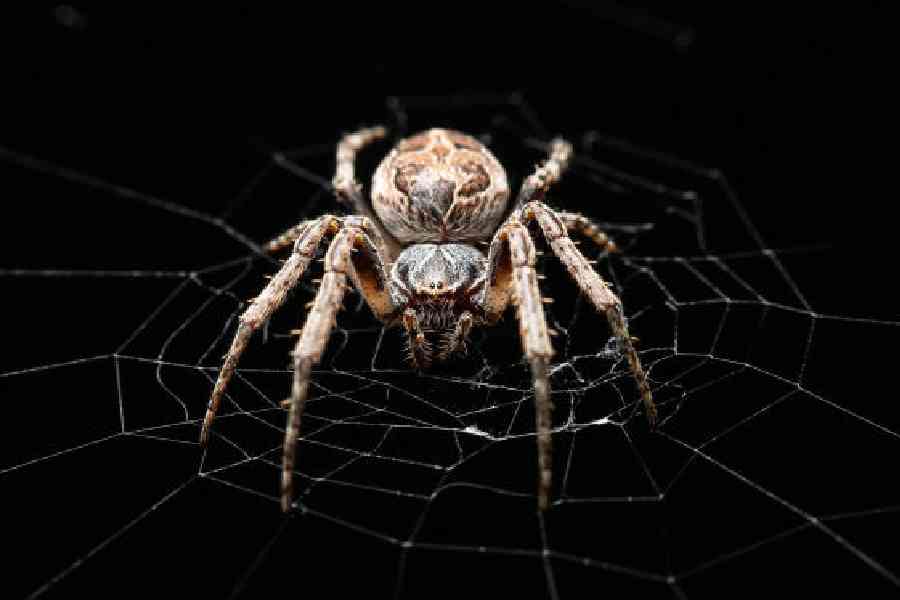Engineers and scientists have a fascination for spider silk. Similar to worm silk that makes for comfy bedsheets but much tougher, the material has inspired the invention of lighter and more breathable materials that could make airplane parts stronger without adding weight. Researchers are even using examples drawn from spiderwebs to design sensitive microphones that can one day be used to treat hearing loss and deafness.
Spiders use their webs like external eardrums. A team of scientists from New York’s Binghamton University and Cornell University, both in the US, reported in 2022 that webs allow arachnids to detect sound from 10 feet away.
When you hear a sound through your ear, what you’re really experiencing are changes in air pressure that cause your eardrum to vibrate. This is how microphones work: by mimicking the human ear and vibrating in response to pressure.
Spiderwebs serve a similar purpose but use a different mechanism. Instead of vibrating when hit by a wave of pressure, they move with the flow of the air being displaced. Air is a fluid medium “like honey”, said Ronald Miles, a professor of mechanical engineering at Binghamton. Humans navigate this environment without noticing much resistance, but silk fibres are buffeted about by the velocity of the viscous forces in air.
Miles couldn’t help but wonder if this principle could lead to a new kind of microphone. “Humans are kind of arrogant animals,” he said. “They make devices that work like they do.” But he wondered about building a device to be more like a spider and sense “sound with the motion of the air”.
He and his colleagues — including Jian Zhou, also a mechanical engineering professor at Binghamton, and Junpeng Lai, a postdoctoral researcher — designed and built a microphone inspired by the principles of natural spider silk. They presented their research recently at the Acoustical Society of America in Ottawa, Ontario.
The device is composed of an extremely thin cantilevered shaft (like a diving board) made of silicon that responds to minute fluctuations in air flow created by sound. To turn that into something humans can hear, a laser measures the shaft’s subtle movements, like a spider decoding its web.
A drawback of typical microphones that sense pressure, Miles said, is that making them better often means making them larger. Think of the chunky mics you see in a recording studio, compared with the spindly headsets used by a motivational speaker. With a spider-inspired microphone that responds to airflow rather than pressure, Miles said, “you can make it quite a bit smaller without paying a price”.
Helping people hear could be the natural next step.
Somewhat counterintuitively, our ears emit sounds when they vibrate in response to pressure. With funding from the National Institutes of Health, Miles’ team will develop a probe that measures these very quiet otoacoustic emissions. That could help with earlier detection of hearing problems in an infant’s ear, for instance.
Another advantage of sensing airflow to measure sound is that it can be used to localise a sound’s source. This could improve hearing aids designed to pick up sounds coming from a specific place in a noisy environment, Miles added.
Anna Rising of Sweden’s Karolinska Institutet agreed that spider silk has potential medical applications. It is known for its toughness, she said, but it is also “well tolerated when implanted and has been shown to enable peripheral nerve regeneration” in animal experiments.
Miles is excited about using a web-inspired microphone to detect infrasound, which is below the human range of hearing. That could be useful for tasks like tracking tornadoes. “Being able to localise the sound of those very low frequencies is really hard with pressure microphones,” he said. “With a velocity-sensing microphone, you could do it very easily.”
Spider-inspired microphones have a long way to go before they’re ready. If the research bears fruit, perhaps humans may break free of the biases that lead to devices inspired by our bodies, giving way to more inventions drawn from how spiders and other creatures perceive the world.
NYTNS











